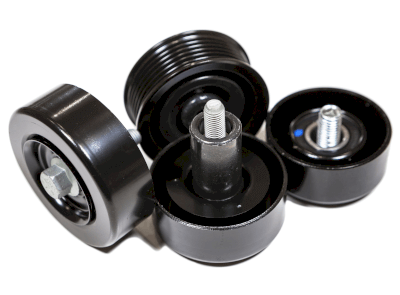What Is an Idler Pulley?

An idler pulley primarily guides V-belts, timing belts, and drive chains. It is responsible for restraining and positioning the belt within a machine. Various designations, such as idle gear, idle pulley, and idle wheel, are used to describe it.
“Idling” is a technical term in machinery, meaning “not in use” or “idle.” The “idler pulley” is named after this term, supporting the tensioner pulley that adjusts belt tension.
This article primarily discusses idler pulleys as automotive parts.
Uses of Idler Pulleys
Idler pulleys are commonly used in V-belts and timing belts, and are widely employed in automobiles and industrial machinery. In automobiles, these belts drive fans, air conditioners, and power steering systems and are involved in operating valves related to engine ignition. Tensioner pulleys adjust the tension of these belts, and idler pulleys are installed opposite the belt to reduce bouncing and flapping.
Features of Idler Pulleys
Idler pulleys are circular and contain an internal bearing. They have grooves on the outside for attaching a belt, allowing the installation of V-belts or timing belts. When drive torque is transmitted from the crankshaft through the belt, idler pulleys rotate, clamping the belt and transmitting torque to the camshaft.
Unlike tensioner pulleys, which adjust tension, idler pulleys do not have mounting holes for springs or slots in the bracket for position adjustment. They only feature a bearing for rotation and a groove for mounting the belt. Their primary function is to rotate in conjunction with the tensioner pulley.
However, the tensioner pulley alone can only secure the belt on one side. Therefore, the idler pulley is essential for clamping the belt from both sides.
As idler pulleys have built-in bearings, regular replacement is crucial to prevent sticking or seizure. In automobiles, it is recommended to replace idler pulleys along with the V-belt and timing belt after a certain mileage, such as 100,000 km.